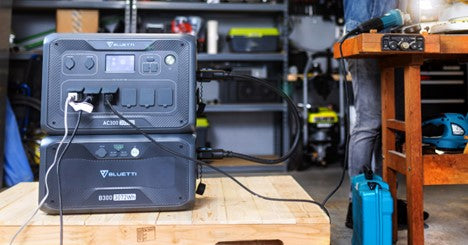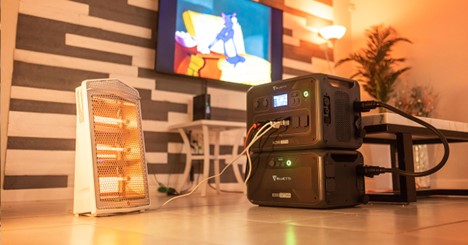Electricity is the cornerstone of civilization. Once it's cut - chaos ensues. It's the unseen force that fuels our lives in everything from how we relate to loved ones, how we earn our living, how we heal bodies, in food storage and more. However, storms and other events threaten power outages.
The best solution for power outages is solar power. Specifically solar generators. Unlike gas- or diesel-powered generators, portable solar generators use a free, abundant, and renewable source of energy to produce electricity – the sun.
Due to developments in portable solar panel technology, these solar generators are quickly gaining popularity as energy options for off-grid cabins, RVs, and small electrical appliances during camping trips. In today’s post we’ll explore what solar generators are, how they work and how they can maintain steady electricity supply.
What Are Solar Generators?
Solar generators are tools that harness the sun's energy to store clean energy that may be used when you need it (during blackouts, for example).
They offer a number of AC outlets, USB ports, and 12V DC carports output, all of which enable you to charge several devices at once. Moreover, since solar generators are available in a wide range of sizes, functions, and capacities, you can find one that suits your specific needs.
Solar generators are low-maintenance, quiet machines. Although they have a high initial cost, the low operational and maintenance expenses make them quite cost-effective in the long-run.
They can also help lower your electricity bills: you can charge the generator in off-peak hours when the electricity cost is low and use it during the peak period.
Main Components of a Portable Solar Generator

To provide the above capabilities, solar generators are an all-in-one device comprising the following components:
Solar Battery: Lightweight, usually made using lithium-ion.
Charge Controller: Manages the battery's applied voltage. This allows you to charge the solar generator in a variety of ways, including sunlight, 12V DC carport, AC charging, and others. A charge controller is required to manage the various inputs supported by the portable solar generator.
Inverter: Turns the battery's direct current (DC) into alternating current (AC) – the kind of current used by most electrical devices and appliances.
Can Portable Solar Generators Power a House?
A solar generator can, for instance, power camping equipment, but it is not designed to meet the needs of a full house.
The average household in Australia uses around 13.7 kilowatt-hours of energy in a day, translating to over 400 KWH of energy in a month, which is quite a lot.
The majority of portable solar generators (which typically have capacities between 500 and 1000 WH) cannot produce that much energy. Having said that, certain solar generators are modular, and this feature considerably increases their capacity, making them a viable choice as a backup source for home power.
Rare Occurrences
Additionally, it's vital to keep in mind that solar generators for homes are only employed in exceptional circumstances, such as a blackout. These circumstances would necessitate less than usual energy consumption.
Consider this: you wouldn't likely use your generator to power your washing machine or dishwasher during a blackout; instead, you would reserve your meagre energy for more important devices (unless the solar generator can power the entire house).
How to Estimate Your Energy Demands
The first step is to decide which appliances your solar generator will be used to power.
Each appliance has its own specs for current (in amperes) and voltage (in volts). Once you find these numbers, you can calculate an appliance’s power ratings through the following formula:
Power = Voltage x Current
After calculating the power needs of your devices, you must determine the number of hours that you want each appliance to run.
For example, a refrigerator is a necessary home appliance, thus you should take into account its energy use.
An average-sized refrigerator has a power rating of around 450 W. Now, assuming that you want your solar generator to power your fridge for a 6-hour period, the refrigerator’s total energy requirement would be:
Energy Requirement (Watt-Hours) = Power (Watts) x Operational hours (Hours)
Energy Requirement (Watt-Hours) = 450 Watts x 6 hours = 2700 Watt-Hours.
So, there you go – in order to power a 450-watt fridge for a period of 6 hours, you would need a portable solar generator with a capacity of at least 2700WH.
The same calculation can be used to determine the number of Watt-Hours needed to power your entire house for a given number of hours.
How to Choose the Right Solar Generator
After you have estimated the amount of energy you need to see off a blackout, you can start searching for a portable solar generator with features that best serve those needs.
If your entire energy calculation came to 600 watt-hours, you must choose a solar generator that can deliver a little bit more than that. This is because you will also need to factor in the efficiency with which the inverter converts DC electricity into usable AC electricity. Other than that, you also must consider the discharge depth (around 80% for a typical LifePO4 battery).
By getting a solar generator whose capacity equals your energy demand, you run the risk of running out of backup power. For this reason, always account for efficiency losses.
Besides, every solar generator comes with different features (output and input options, for instance), so, the better you understand your preferences, the easier it will be for you to pick a portable solar generator.
How Much Do Portable Solar Generators Cost?
Your initial investment will depend upon how many watt-hours you need.
Assume that you want portable solar power for an emergency to run just a few basic items, such as light bulbs, a stove, a fridge, and a phone charger, for a few hours until the grid power is restored. In this case, a medium-sized portable solar generator will work quite well for your needs.
These solar generators typically provide between 3 and 5 kWh, and they range in price from $2,500 to $6,500.
Now, let us assume you want to power a number of appliances over a period of several hours (or even days). In this case, only a high-capacity portable solar generator with expendable battery units will be able to cater to your requirements.
These high-capacity generators can be created by adding battery extension modules. This system can offer between 8 KWH and 13 KWH (some models can even offer as much as 24 KWH) of power. Your investment here might be between $10,000 and $20,000.
Where Should You Store Your Portable Solar Generator?
Unlike their conventional gas- or diesel-powered counterparts, solar generators do not release any toxic fumes or other substances, nor do they pose the threat of flammable oil spills.
Moreover, they are considerably less noisy than conventional generators (conventional generators are extremely noisy since they use an alternator to produce electricity). In contrast, solar generators use chemical energy to store the power they get from solar panels (in solar batteries). The battery transforms the chemical energy into usable electrical energy as needed. There is absolutely no sound made during this process.
The only sound that solar generators make is that of the internal cooling fan that is installed to keep the generator from overheating (even then, the fan is only a part of a small handful of solar generator models). The noise of the fan is quite similar to the kind of sound produced by a CPU (Central Processing Unit), and is, therefore, not as distressing or disturbing as the noise produced by traditional generators.
Owing to the above reasons, you can keep a portable solar generator wherever you feel is most practical for you.
In fact, you can even utilise a generator transfer to link the portable solar generator with the main electrical panel in your house.
Other than that, as long as weather permits, you can also safely keep your portable solar generator outdoors when you want to power any backyard appliances.
How to Maintain a Portable Solar Generator
Here are a few tips for maintaining your solar generator and maximising its efficiency and useful life:
- Storage: When storing your generator, make sure it is turned off and is between 50% and 80% charged. If you are storing the generator for an extended period, make sure to completely discharge and recharge the unit once every 4-6 months.
- Environment: Keep your solar generator away from severe or rainy conditions. Also make sure to keep the system away from any flammable gases or other substances.
- Cleaning: Use a non-abrasive piece of cloth to clean the generator whenever needed.
- Temperature: Make sure to charge the generator between a temperature of 32 degrees Fahrenheit (0 degrees Celsius) and 113 degrees Fahrenheit (45degrees Celsius).
- Battery lifecycle: To prolong the battery’s useful life, do not deviate from the recommended discharge depth.
- Self-discharge: If you plan to store the device for a long time, you should discharge and recharge it completely at least once every 4-6 months.
- Ventilation: Place the portable solar generator in a well-ventilated area when using or storing it.
How to Reduce a Portable Solar Generator’s Charging Time
The main advantage of a portable solar generator is that it can be recharged using solar energy; depending on the generator's capacity and recharge rate, recharging can take anywhere between 6 and 8 hours.
However, many solar generators can sustain high input rates, which means you can increase their charging rate and, consequently, reduce the charging time.
For instance, the BLUETTI AC300 (complemented with the B300 battery unit) allows for a maximum 3000W AC charging using a wall outlet, and 2400W charging through solar panels.
These higher-capacity portable solar generators also come with amazing dual features that allow you to maximise the charging input by using multiple charging methods at the same time.
The AC300, then, gives you a combined charging input of 5400W when you use both the solar panels and wall outlet simultaneously. This can significantly accelerate the recharging process and cut the recharging time down to 1.5 to 2.2 hours.
Generally, a high-capacity portable solar generator with dual charging capability can be recharged fully in around 2 hours.
Get a Portable Solar Panel for Your Emergency Power Needs

Portable solar generators are an excellent option for people who want to prepare for natural disasters or electricity outages.
Many solar generators offer compatible battery units that help expand their capacities. This high capacity can be enough to power a number of home appliances for several hours or days on end.
If you are looking for a portable solar generator for emergency needs, we invite you to check out our wide range of options. We offer a number of portable solar generators and can help you pick the one that best serves your budget and RV power requirements.
To learn more about portable solar generators for emergencies and explore your options, please feel free to get in touch.




